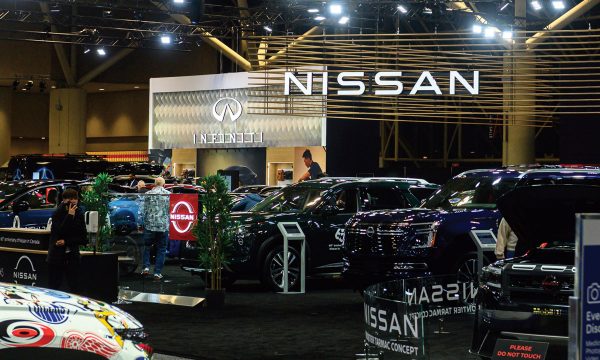Auto shows play an integral role in EV awareness and education
The adoption of electric vehicles (EVs) by Canadian consumers has not exactly gone as planned.
While EVs remain a central focus for the federal and (some) provincial governments, as well as for manufacturers, enthusiasm for EVs among the general public is mixed. While consumer demand for electrified vehicles exists, it has not grown at anywhere near the pace required to achieve the federal government’s 100 per cent ZEV-only sales goal by 2035.
It is not a coincidence that Canada’s three most important industry groups — CADA, GAC, and CVMA — have intensified efforts this year to educate policymakers to this reality.
As discussed in my last column, Clarify has partnered with Canada’s three largest auto shows — the Canadian International AutoShow (CIAS) in Toronto, Salon d’Auto de Montréal, and the newly rebranded Elevate Vancouver Auto Show — to conduct a comprehensive Visitor Experience Study examining the motivations, behaviours, and preferences of show attendees. We collected feedback from nearly 11,000 show visitors across the three cities.
The last column examined the positive impact of auto shows on overall consumer behaviour. This time, we’ll go deeper into two key questions both OEMs and Dealers have on the subject of Zero Emission Vehicles:
- How knowledgeable are Canadian consumers with respect to EVs?
- What is the current level of interest in EVs and how likely are consumers to actually consider one?
EV familiarity before visiting the auto show = not very
Most Canadians remain unfamiliar with electrified vehicles. Only 1 in 4 visitors to CIAS in Toronto (24 per cent) rate themselves as very familiar with EVs, including those who already own one.
While EV familiarity improves among visitors to the Montréal and Vancouver shows (33 per cent), it still means the vast majority (up to 76 per cent) of Canadians are relatively uniformed.
This is where Canadian auto shows play a vital role in elevating consumer awareness and familiarity. In fact, many CIAS visitors tell us they attend to discover and learn more about automotive innovations (44 per cent) and nearly 1 in 5 visitors (19 per cent) state that learning more about EVs is a primary reason for coming to the show.
The EV Test Tracks (indoor and outdoor circuits) are important experiential tools to educate and inspire consumers. CIAS conducted over 15,000 EV drives this year. The in-person experience provided by the auto show is a powerful tool for OEMs to get their unique EV story out.
Show visitors, and EV test track participants in particular, are not just casual observers, they’re actively researching if and how an EV can fit into their daily life—everything from understanding realistic expectations of range, to charging times, battery warranties, software updates, and more.
The good news for OEMs who invest in onsite EV engagement? In comparison to the average of all show visitors, EV test track participants at CIAS are:
- More likely to use the show to help them decide on their next vehicle (44 per cent vs 39 per cent)
- 2.7 times more likely to choose a BEV as their next new vehicle (22 per cent vs 8 per cent)
- Nearly twice as likely to recommend the show (1.94 times higher) to their family, friends and colleagues
- More likely to go online to research a model (63 per cent vs 53 per cent), visit a dealership (38 per cent vs 35 per cent), and arrange a test drive (38 per cent vs 25 per cent)
What is the current level of EV interest and how likely are Canadians to actually consider one?
Which brings us to the challenge our industry now faces.
Despite continuous EV technology and public charging infrastructure improvements over the last few years, these enhancements have been insufficient to entice the bulk of consumers away from the Internal Combustion Engine (ICE).
When asked about which powertrains they are considering for their next vehicle, only a minority of Canadians indicate a BEV is on their list, from a low of 18 per cent among CIAS visitors, to 27 per cent among visitors to both the Montréal and Vancouver shows.
However, when asked for their single most likely option, BEV consideration falls dramatically to only 8 per cent in Toronto, 17 per cent in Vancouver and 21 per cent in Montréal, well below the adoption rates required to reach Canada’s Electric Vehicle Availability Standard, not to mention the provincial mandates in BC and Québec. Even more concerning, BEV consideration rates are declining year-over-year among CIAS and Montréal visitors. And the story for PHEVs is no more encouraging.
It seems that while the Canadian auto shows successfully attract EV-curious consumers and provide excellent EV education and experiential opportunities onsite, the number of consumers actually willing to buy one lags the level of interest.
This “EV Intention Gap” speaks volumes about the current state of the Canadian car buyer’s mindset and points to both a challenge and an opportunity for OEMs, dealers, and policymakers alike. The interest in adoption is there, so what is the disconnect between BEV consideration and intention?
Among visitors to 2025 CIAS, the Top 3 reasons for BEV rejection are:
- High purchase price (52 per cent)
- Limited driving range (51 per cent)
- Limited public charging infrastructure (49 per cent)
While rejection percentages are lower among visitors to the Montréal and Vancouver shows, the Top 3 rejection reasons are remarkably consistent across the country.
The bottom line:
The global industry is well past the point of return on the EV transition, despite the new U.S. administration’s eagerness to slow it down. In Canada, there is little debate whether the EV transition will happen, but much debate on when it will be achieved.
As new battery and software technologies are introduced to increase range and decrease charging times, and new incentives and infrastructure investments are made available, in-person auto shows remain the most effective channel for manufacturers and policymakers to communicate key messages to consumers. This education opportunity takes on even more significance given that the majority of show visitors are in-market with the intention to purchase their next vehicle within the next 24-months (65 per cent of consumers at CIAS).
From a dealership perspective, there are two key takeaways:
- If you have the opportunity to send members of your sales team to a Canadian auto show, take it. The Canadian shows attract in-market buyers and provide a great opportunity to introduce EVs to consumers who need the expertise of a trusted advisor to guide them;
- Ensure that your sales and service staff are, in fact, trusted advisors for your customers, knowledgeable and confident about the EV models they are selling and servicing, those of your key competitors, and with enough “I’ve walked a kilometer in your shoes” experience with EVs to properly advise prospective customers on which vehicle, electrified or not, will best meet their needs.












